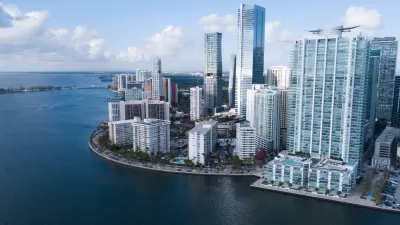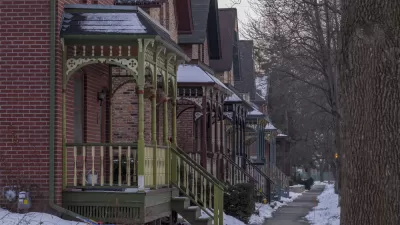Waterfront views and large parcels of vacant land should be a good urban revitalization in a growing city like Philadelphia, but the Central Delaware waterfront has fallen short of expectations.
Inga Saffron reviews the goals and results of a master plan approved in 2011 to remake the Central Delaware waterfront in Philadelphia.
The key approach of this plan, according to Saffron, was to aim for something different than the skyscraper-lined model of Vancouver and Miami.
By spacing out those smaller buildings, the thinking went, the city would create the beginnings of a true urban streetscape along Delaware Avenue. The mid-rises would populate the river, bringing just enough people to Delaware Avenue to support retail and justify adding a trolley line. The waterfront’s zoning was adjusted to make it easy to erect buildings under 25 stories, using a category called CMX-3.
While that seemed like a sound strategy at the time, Saffron makes the case that the results in 2019 have fallen far short of the ambitions described in 2011.
"Only one mid-rise has gone up over the last decade: PMC’s 16-story One Water Street, next to the Ben Franklin Bridge. Virtually every other residential project has been townhouses," reports Saffron. The maximum extent of the building envelope has not been realized, and the city is falling short of its vision for a "walkable, mixed-use riverfront neighborhood."
Saffron digs into more detail about why the townhomes that have been developed since 2011 fall short of the vision established by the Master Plan for the Central Delaware. There's even the development of a cap park to consider (work started in 2018), but even that hasn't convinced developers of adjacent projects to ditch to townhome development scheme.

Alabama: Trump Terminates Settlements for Black Communities Harmed By Raw Sewage
Trump deemed the landmark civil rights agreement “illegal DEI and environmental justice policy.”

Planetizen Federal Action Tracker
A weekly monitor of how Trump’s orders and actions are impacting planners and planning in America.

Why Should We Subsidize Public Transportation?
Many public transit agencies face financial stress due to rising costs, declining fare revenue, and declining subsidies. Transit advocates must provide a strong business case for increasing public transit funding.

Understanding Road Diets
An explainer from Momentum highlights the advantages of reducing vehicle lanes in favor of more bike, transit, and pedestrian infrastructure.

New California Law Regulates Warehouse Pollution
A new law tightens building and emissions regulations for large distribution warehouses to mitigate air pollution and traffic in surrounding communities.

Phoenix Announces Opening Date for Light Rail Extension
The South Central extension will connect South Phoenix to downtown and other major hubs starting on June 7.
Urban Design for Planners 1: Software Tools
This six-course series explores essential urban design concepts using open source software and equips planners with the tools they need to participate fully in the urban design process.
Planning for Universal Design
Learn the tools for implementing Universal Design in planning regulations.
Caltrans
Smith Gee Studio
Institute for Housing and Urban Development Studies (IHS)
City of Grandview
Harvard GSD Executive Education
Toledo-Lucas County Plan Commissions
Salt Lake City
NYU Wagner Graduate School of Public Service





























